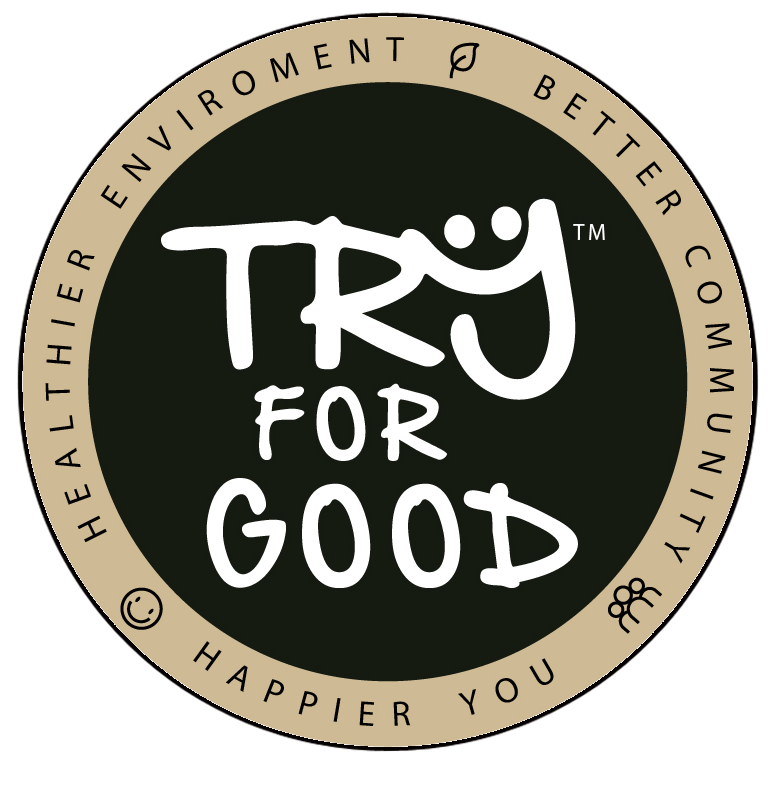Plastic Garbage and Animal deaths
Rachel Wright, Owner TOLFA (Tree of Life for animals) in conversation with Dr. Anju Dave Vaish.
They discuss about unsustainable development in India, increasing plastic garbage, animals dying due to that, and possible solutions.
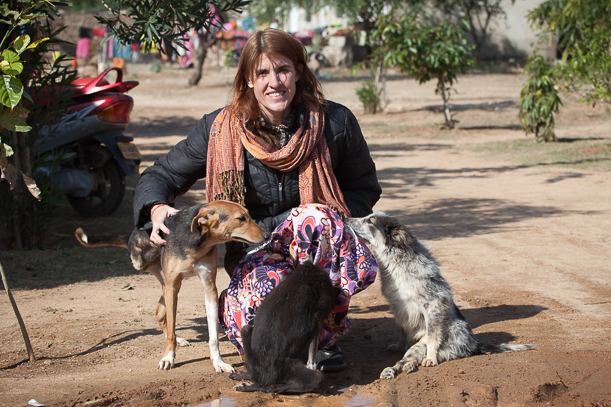
Rachel Wright, the founder and director of the Tree of Life for Animals rescue center in Pushkar, India
Anju: Foremost, I would like to congratulate you on your great endeavor and the success that you have achieved by not just rescuing animals but inculcating a sense of compassion and responsibility for stray animals in the community.
Earlier, there were only 10% stray animals which used to see the care, rescue or emotional attachment from humans.
Rachel: Thank You! It has been 11 years since I formed TOLFA. Starting in 2001, we built the hospital which is located in a village near Pushkar called as Kharekhari. It helps with animal rescue and other services such as treatment, vaccination and other welfare. In these years we have seen tremendous success with an emotional shift for “care” for the stray animals. Earlier, there were only 10% stray animals which used to see the care, rescue or emotional attachment from humans. Now the same has been soared to 60-70%. Now people are becoming more passionate. It is a very positive thing.
Anju: There are so many stray animals’ deaths happening due to choking on plastic in India today. It is a sad situation that on one hand there is so much of development, but on the other there is everywhere the landfills with plastic. In India, cows have been worshipped from the ancient civilization. Today we see those dying carrying 25-30kgs plastic in their bodies. What are your thoughts and TOLAs action points on the same?
Rachel:
It is really a very HUGE problem. Milk consumption is increasing day by day, more babies are being born, out of which 50% are male calves which are of no use and left in the streets. They starve or feed on the rubbish. Bulls and cows are literally dying in 100s and 1000s. There had been a ban of plastic in Rajasthan, but unfortunately it has not been enforced.
77% of the total cows/ bulls admitted from Ajmer (by both the AMC & TOLFA) that were inlateral or sternal recumbency died
Besides the animal care, TOLFA also lobbies with local administration and government as well. In 10 years TOLFA has admitted over 4,800 cows and bulls from Ajmer and has provided almost 50,000 medical treatments to those animals. The number of cows/ bulls being admitted from Ajmer grew steadily from 2006 to 2012. In 2014-15 we rescued and treated 863 cows / bulls from Ajmer. 77% of the total cows/ bulls admitted from Ajmer (by both the AMC & TOLFA) that were inlateral or sternal recumbency died. This means a complete state of collapse due to severe malnutrition and stomach impaction caused by eating plastic and rubbish. Although operations can be performed to remove the plastic while the animals are still standing, by the time they are in a collapsed condition there is no treatment to this, except for the painful gradual death of the animals!
TOLFA also has an Education Project as well, where we teach children about keeping the vegetable matter separate from the rest of the garbage. Mostly people will throw food in plastic bags and cows and other animals just end up feeding on those.
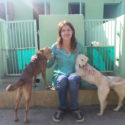
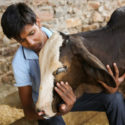
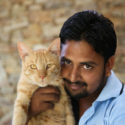
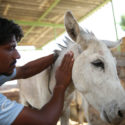
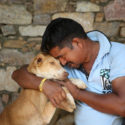
Anju: So you do feel that Garbage segregation is highly important for animal protection.
Rachel: Yes it is. Vegetable matter must not be packed in plastic. Plastic or dry waste should go into the bins. The rubbish situation will improve if the Municipality starts with the garbage segregation.
Reduction of plastic use is now being observed in all other developed countries too, though they do not have stray animal issues.
The rubbish problem is the root cause of many stray animals’ health problems and deaths.
Anju: Culturally India was always animal friendly. People used to make water reservoirs and take out a “roti (bread)” for cows and “dogs” Today people are just consuming and trashing being ignorant of the grave consequences. With cows, Indians always have had religious sentiments too with great value system around them. But today the cows, bulls and other stray animals are feeding on rubbish that includes plastic and other toxic waste. Instead of throwing food waste or vegetable matter in plastic, they could probably use newspapers if the eco-plastic bags are not available?
Rachel : People don’t realize. They are horrified when they are exposed to the facts. If there is less plastic on the roads, cows and other animals will be saved.
Newspaper is biodegradable so it is a good idea to use that to trash food instead of plastic. People education, awareness building, garbage segregation and enforcements from the Government are all very important to put together to save animal lives. There are many bio-degradable solutions emerging on the landscape.
Anju: You must be aware of the Hingonia cow shelter and significant number of cows being released in Jaipur and around. What is your take on that?
Rachel: There is no excuse for neglecting animals that are in your care but it should also be recognized that many of the cows when brought to such shelters are already in a collapsing situation. They are severely malnourished and their stomach stops churning after sometime due to the impaction caused by the plastic. They manage for some time, but then it starts shutting down
Anju: I am holding one thought with which I am a bit too intrigued… Why Pushkar of all the places? What about replicating the model at other places?
Rachel: After serving as veterinary nurse in UK, I travelled to Africa, Asia for about eight years. Sitting on a beach of Sri Lanka I was visited by this dog that was not able to eat because of a stick stuck in her mouth. As I helped her, she started to bring a dog everyday with her, who had their own problems. With my skills I was able to help, and then this idea struck that I have to set up a veterinary hospital and an animal shelter where there is lack of such facility and provision.
On seeing this picture of four dogs tied together to a wooden log and left to die in the heat of the desert without food and water, I was shocked to the core.
When I came to Ajmer I was shocked to learn about the stray dog control. On seeing this picture of four dogs tied together to a wooden log and left to die in the heat of the desert without food and water, I was shocked to the core.
I learnt that every year in Ajmer, an Urs mela is held where thousands of pilgrims come to visit the famous Dargah shrine. At that time the dogs were seen as a public health risk. Instead of catching and dumping the dogs in the desert, I went to the Municipality to give me a temporary place where we could both keep the dogs and sterilize and vaccinate them while the festival was going on. It worked very well. The municipalities were happy.
I knew that this is where I was needed the most. So I found that this is my “dharma” and it is my “kismet” to show me the path here to Pushkar and Ajmer.
We built the hospital. We worked together with Municipality since 2007-2009 and again in 2016 for the sterilization and vaccination programs for stray animals. Since then we have seen an improvement in dog bite cases.
Now in Ajmer, we have set up the Dog monitoring committee, which includes the mayor, municipality CEO and commissioner, animal NGOs, Animal husbandry dept., Govt human Rabies unit etc.
There are many similar organizations that are spreading love and care for animals. There is one in Jaipur ‘Help in Suffering’ operational for last 35 years, another one in Udaipur “Animal Aid Unlimited. There is an International Network by the name of World Animal Net. They provide a list of all the NGOs in each major cit.
Anju: What is TOLFA’s submission to the general masses on the given stray animals and waste management?
Rachel:
- Do not throw vegetable matter away tied in plastic bags. You can use Newspaper instead. The animals get attracted to the food but cannot remove plastic from it and they become impacted by it or die of toxic substances lying in their bodies
- Separate food waste from plastic waste always. Put plastic waste into the bins
- Do not burn plastic as this releases toxins in the environment which are quite harmful for animals as well as humans
- Build pressure of maintenance through local bodies
- Use your own cloth bags for grocery or other shopping. Do not use plastic bags
- It will make a difference if we control plastic bags from our side.
- Education is a big part for any of this kind of work. People are unaware. I wish luck to TRY for Good for doing that.
Anju: Thank you so much. We hope that while the Government and the Municipalities take some action towards garbage segregation, animal shelters, we as citizen must take a step back to think and change our habits of unthoughtful consumerism and disposal. In general we make our buying decisions based on the quality, style, comfort, and price. We must be equally thoughtful about recycling, landfills and at least NOT ASKING PLASTIC BAGS from the Shopkeepers and explore alternative and eco-friendlier solutions.
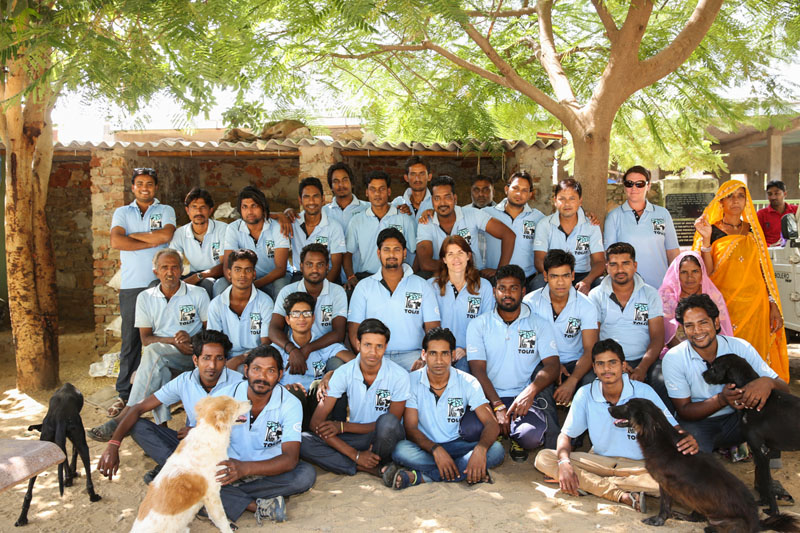
Must watch the heart wrenching video “The Plastic Cow”. Those who want to just get the facts straight must watch from 21:56- 26:30
